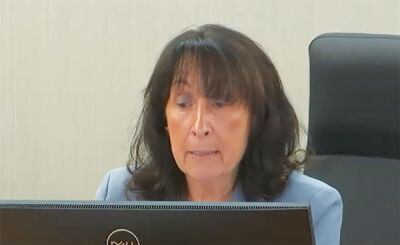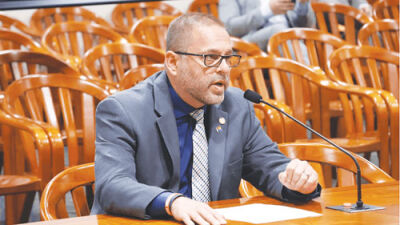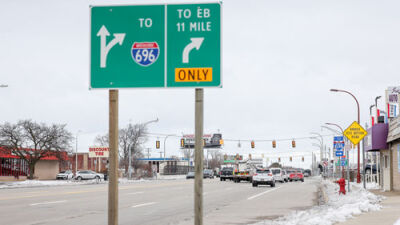
Debbie Binder, a West Bloomfield trustee and a township clerk, discusses the options for a water rate increase during a study session June 10.
Screenshots from June 10 broadcast

Vincent Kirkwood, a township trustee, preferred more gradual rate increase options.
Screenshot from June 10 broadcast
WEST BLOOMFIELD — During a meeting of the West Bloomfield Board of Trustees June 23, members voted for a 23% water rate increase and 13% sewer rate increase, an option referred to as “Rip the Band-Aid Off.”
The change went into effect with the July 1 meter reading.
The “Rip the Band-Aid Off” model starts off with the highest rate increases for both water and sewer, followed by four years of the lowest increases at around 4% increase for each year.
The township’s director of finance, Susan Hendrick, recommended the option, as did the township’s director of water and sewer utilities, Justin Taylor.
“We would end up at the end of five years with the lowest rate, though it is a large increase in the first year,” Hendrick said.
Brian Camiller, an accountant with Plante Moran, conducted the water sewer rate study for the township and presented his findings at the June 3 meeting and at a June 10 work session.
Three models were discussed. In addition to “Rip the Band-Aid Off,” there was an option called “Steady Eddie” where the increase would be the same each year for five years, estimated at around 10% each year for water and 7% for sewer, and “Slower Band-Aid Pull,” which starts with a water increase of about 18% the first year with 6% increases each year for four years, and an 18% increase for sewer rates the first year, with a nearly 2% increase each of the next four years.
Camiller emphasized that the numbers were projections and will be evaluated each year, and may be subject to fluctuations up or down.
It was for this reason that Debbie Binder, a West Bloomfield trustee and the township clerk, proposed to vote on implementing the 23% increase for the water bill the first year.
“In looking at a five-year projection … we don’t know (what will happen during) the following years. I think we should probably deal with what’s known, instead of potentially wishful thinking or the unknown,” Binder said.
The resolution was adopted by a vote of 4-1. Absent from the meeting was trustee Diane Rosenfeld Swimmer, who is a nurse and was working, according to Jonathan Warshay, the township supervisor. Trustee Jim Manna notified the board he would be late.
Trustee Vincent Kirkwood, the lone dissenter, was in favor of the “Steady Eddie” model.
“(For) a young family, 23% is hard, 10% is hard,” Kirkwood said.
Although he was of a different opinion than his fellow trustees, Kirkwood praised the thoughtfulness of their decision-making process and the in-depth discussions of the group.
“I think the board has done their due diligence with the staff to understand their reasoning why they’re going with the 23% (increase the first year). It was well thought out — just not my first option,” Kirkwood said.
“This is where the effectiveness of a board approach is helpful,” Binder said. “Because I thought I was going in one direction, but when you listen to the points of others, your perspective sometimes shifts.”
According to Camiller, municipalities in the region have been slow to raise their water rates to keep pace with inflation. The rate hike is a way to get the township “back on track.”
The Great Lakes Water Authority is the entity from which the township purchases water. While the GLWA raised its rates 6%, there were other variables that factored into the rate increase.
“The township must pay Oakland County for sewage disposal and infrastructure needs, (which) the county determines for the regional system,” Binder said.
The township also has significant capital improvement needs for local water and sewer systems “to ensure (the) longevity and function of our (water) systems,” she said.
Water loss also affects water rates.
“That is water you purchase that is lost through the system,” Binder said.
West Bloomfield has had low water loss compared to other communities. In recent years, the water loss rate increased but is still low. According to Binder, the lower rates in prior years were because of a metering issue at the GLWA station that was in the township’s favor.
“Every infrastructure needs investment in about 50 years, even with routine and appropriate maintenance,” Binder said. “Our water and sewer systems were originally installed in the mid-70s. We have reached a point where it is time to replace some of the existing components to ensure safe drinking water and a reliable sewer system.”
Oakland County residents who need assistance paying their water bills are encouraged to contact United Way Southeastern Michigan at (844) 211-4994.
Additional resources are available by contacting the township supervisor’s office at (248) 409-1581, or the water and sewer division at (248) 451-4780.
 Publication select ▼
Publication select ▼





















